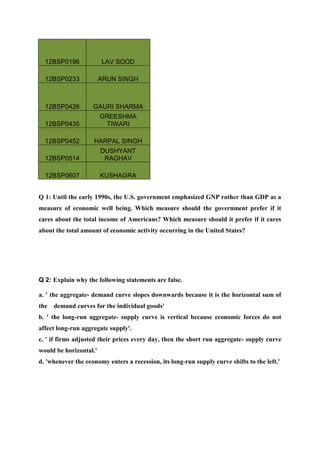
Economics project
- 1. 12BSP0196 LAV SOOD 12BSP0233 ARUN SINGH 12BSP0426 GAURI SHARMA GREESHMA 12BSP0435 TIWARI 12BSP0452 HARPAL SINGH DUSHYANT 12BSP0514 RAGHAV 12BSP0607 KUSHAGRA Q 1: Until the early 1990s, the U.S. government emphasized GNP rather than GDP as a measure of economic well being. Which measure should the government prefer if it cares about the total income of Americans? Which measure should it prefer if it cares about the total amount of economic activity occurring in the United States? Q 2: Explain why the following statements are false. a. ' the aggregate- demand curve slopes downwards because it is the horizontal sum of the demand curves for the individual goods' b. ' the long-run aggregate- supply curve is vertical because economic forces do not affect long-run aggregate supply'. c. ' if firms adjusted their prices every day, then the short run aggregate- supply curve would be horizontal.' d. 'whenever the economy enters a recession, its long-run supply curve shifts to the left.'
- 2. 12BSP0682 MOHIT CHAUHAN 12BSP0687 MOHIT LOHIA 12BSP0818 PALLAVI BHASIN 12BSP0825 PANKAJ SHARMA PRASOON KUMAR 12BSP0883 SINGH 12BSP1079 SAKSHI KAPILA SIDHARTH 12BSP1218 MANCHANDA Q 1: Below are some data from the land of milk and honey. Years Price of Milk Quantity of Price of Honey Quantity of Milk (quart) Honey (quarts) 2005 $1 100 $2 50 2006 $2 200 $2 100 2007 $3 200 $4 100 a. Compute nominal GDP, real GDP and GDP deflator for each year, using 2005 as a base year. b. Compute percentage change in nominal GDP, real GDP and the GDP deflator in 2006 and 2007 from the preceding year. For each year, identify the variable that does not change. Explain in words, why your answer makes sense. c. Did economic well-being raise more in 2006 or 2007? Explain. Q 2: what might shift the aggregate demand curve to the left? Use the model of aggregate demand and aggregate supply to trace through the short run and long run effects of such a shift on output and the price level.
- 3. 12BSP1334 UDAY KUMAR 12BSP1336 UDIT PRATAP SINGH 12BSP1440 SURABHI DAS 12BSP1464 KSHIPRA GANGAY 12BSP1558 MANALI MATHUR 12BSP1599 SAHIL ARORA AVINASH KUMAR 12BSP1658 SINGH Q 1: one day Barry and Barber, Inc., collects $400 for haircuts. Over this day, his equipment depreciates in the value by $50. Of the remaining $350, Barry sends $30 to the government in sales taxes, takes home $220 in wages, and retains $100 in his business to add new equipments in the future. From the $220 that Barry takes home, he pays $70 in income taxes. Based on this information, compute Barry’s contribution to the following measures of income. a. Gross Domestic Product b. Net National Product c. National Income d. Personal Income e. Disposable Personal Income Q 2: suppose that economy is currently in a recession. If policymakers take no action, how will the economy change over time? Explain in words and using aggregate demand and aggregate supply diagram.
- 4. 12BSP1660 BHARTI SHARMA 12BSP1728 KHUSHBOO SHARMA 12BSP1805 RICHA SEHGAL 12BSP1935 RAGINI AGARWAL 12BSP2023 DEEPIKA JHAMTANI 12BSP2024 DEEPIKA SINGH 12BSP2026 DEVESH CHOTALIA Q 1: For each of the following events, explain the short-run and long-run effects on output and the price level, assuming policy makers take no action. a. The stock market decline sharply, reducing consumer’s wealth b. The federal government increases spending on national defense c. A technological improvement raises productivity. d. A recession overseas causes foreigner to buy fewer U.S. goods Q 2: what components of GDP (if any) would each of the following transaction affect? Explain. a. A family buys a new refrigerator b. Aunt jean buys a new house c. Ford sells a Mustang from its inventory d. You buy a pizza e. California repaves Highway 101 f. Your parents buy a bottle of French Wine g. Honda expands its factory in Marysville Ohio.
- 5. 12BSP2030 GAURAV YADAV 12BSP2048 MUNITA SHARMA 12BSP2091 SORAV SHARMA 12BSP2140 SATHI BORAL 12BSP2163 DHEERAJ CHHABRA 12BSP2176 KASHIF HUSSAIN Q 1: suppose that firms become very optimistic about future business conditions and invest heavily in new capital equipment. a. Draw an aggregate demand/ aggregate supply diagram to show the short run effects of the optimism on the economy. Label the new level of prices and real output. Explain in words why the aggregate quantity of output supplied changes. b. Now use the diagram from part (a) to shoe the new long run equilibrium of the economy. (For now assume that there is no change in the long run aggregate supply curve.) Explain in words why the aggregate quantity of output demanded changes between the short run and long run. c. How might the investment boom affect the long run aggregate supply curve? Explain. Q 2: if prices rise, people’s income from selling goods increases. The growth of real GDP ignores this gain, however. Why, then, do economists prefer real GDP as a measure of economic well being.
- 6. 12BSP2202 RAHUL SANWARIA 12BSP2209 SAURAV KUMAR 12BSP2223 VIDHU KHATRI 12BSP2236 AKASH BANSAL 12BSP2340 ASMA CHISHTI 12BSP2341 ATUL KESHARWANI 12BSP2460 MANSI MUNJAL Q 1: what might shift aggregate supply curve to the left? Use the model of aggregate demand and aggregate supply to trace through the short run and long run effects of such a shift on output and the price level. Q 2: the participation of women in U.S. labor force has risen dramatically since 1970. a. How do you think this rise affected GDP? b. Now imagine a measure of well-being that includes time spent working in the home and leisure. How would the change in this measure of well-being compare to the change in GDP? c. Can you think of other aspects of well-being that you associated with the rise in women’s labor-force participation? Would it be practical to construct a measure of well-being that includes these aspects?
